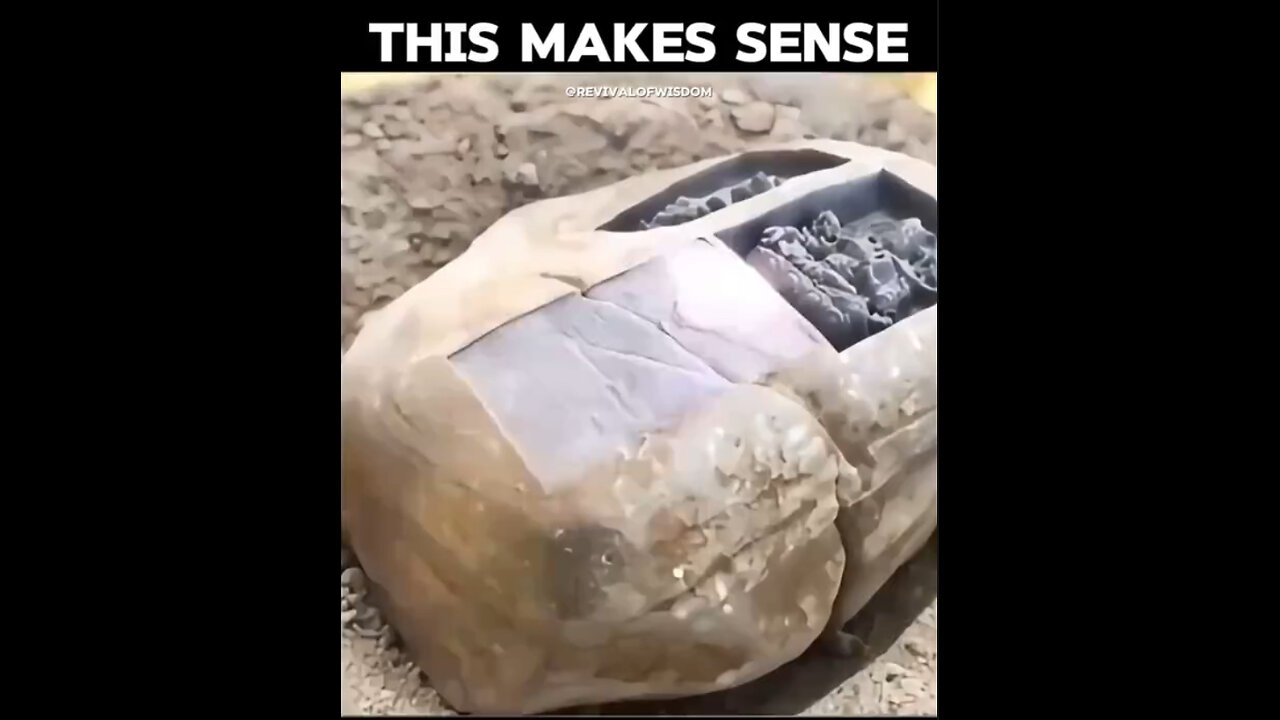Premium Only Content

Rewriting History: The Advanced Laser Technology Theory Behind Ancient Architecture
Human history, as it is conventionally told, is often seen as a steady progression from primitive tools to modern technology. This narrative implies that our ancestors, using rudimentary instruments such as hammers and chisels, painstakingly constructed the grand architectural masterpieces we still marvel at today. However, as we examine the intricacy and precision of many ancient structures, a provocative theory emerges: perhaps these advanced constructions were not the result of primitive tools but of technologies far beyond what modern historians have acknowledged—potentially even laser technology.
The Inexplicable Precision of Ancient Structures
Across the world, we see the remnants of highly advanced civilizations—Egypt’s pyramids, India’s temples, and Peru’s Machu Picchu—all featuring sophisticated designs and incomprehensible levels of precision in stone carving. These buildings, often made from hard materials like granite or basalt, are characterized by their perfect geometric shapes, seamless joints, and incredibly detailed carvings. This level of accuracy has led some researchers to propose that these ancient builders may have had access to tools and technologies that are comparable—if not superior—to those we possess today.
1. Laser-Like Precision
When you examine structures like the Great Pyramid of Giza or the monolithic stones of Puma Punku in Bolivia, one striking feature stands out: the impossibly tight joints between the massive stone blocks. These stones, many of which weigh several tons, were cut and fitted together with such precision that not even a razor blade can slide between them. The cuts on these stones are so sharp and smooth that they resemble work done with modern laser-cutting tools, not the blunt instruments typically associated with ancient civilizations.
2. Geometric Symmetry and Detail
Structures such as the intricate temples of ancient India or the stone reliefs of Egypt feature detailed carvings and complex geometric patterns that seem impossible to achieve with crude tools. Many of these carvings involve deep, narrow cuts and delicate designs, characteristics that would require an incredibly steady hand, a vast amount of time, or—more likely—a technological aid that could guide the hand with extreme precision. The concept that lasers, or some other form of advanced energy-based tools, might have been used offers a plausible explanation for this level of detail.
Anomalies in Historical Narrative: Gaps in Conventional History
The idea that ancient civilizations possessed such advanced technologies challenges the mainstream historical narrative. History, after all, is often said to be “his story”—written by those in power, with biases, omissions, and distortions that may serve particular agendas. What we’ve been told about human progress is a linear story of discovery, from the stone age to the space age, but there are many anomalies that don’t fit neatly into this narrative.
1. Ignored Evidence
Traditional archaeology often attributes these architectural marvels to the brute force of labor, simple tools, and sheer determination. However, there are persistent anomalies that have been either ignored or inadequately explained. For example, how did ancient builders transport multi-ton stones over long distances without the use of advanced machinery? How were they able to achieve such perfect alignments with celestial bodies without telescopes or modern measuring instruments? These questions have long puzzled researchers and remain largely unanswered by mainstream science.
2. The Role of Myth and Allegory
Many ancient cultures speak of advanced beings or gods who provided knowledge and technology to humans. In ancient Egypt, for example, Thoth was revered as the god of wisdom, science, and magic, believed to have taught humans the arts of writing, architecture, and mathematics. In ancient India, Vedic texts describe celestial beings descending to Earth with advanced knowledge. Could these stories of gods and enlightened beings be allegorical references to a forgotten epoch of technological advancement?
Possible Theories for Advanced Ancient Technology
The possibility that ancient civilizations might have employed laser-like technologies is fascinating, and several speculative theories have emerged to explain how such advanced tools might have existed.
1. Lost Technology from a Forgotten Civilization
One theory posits that a highly advanced civilization, such as Atlantis or Lemuria, may have existed in prehistory and that much of their technology was lost during a global cataclysm. Survivors of this event may have carried some knowledge to other parts of the world, where they attempted to rebuild civilization, though the full extent of their technological prowess was lost. This theory aligns with the idea of ancient tools far surpassing what is traditionally assumed to have existed.
2. Extraterrestrial Intervention
Another theory is that ancient civilizations had contact with extraterrestrial beings who shared their technology. Proponents of this idea point to the sudden appearance of advanced mathematics, astronomy, and construction techniques in civilizations such as Egypt, Mesopotamia, and the Mayans as evidence of an otherworldly influence. Could these advanced beings have provided the knowledge or even the tools required to carve stone with laser-like precision?
3. Vibration and Sound Technology
Another speculative yet intriguing theory is the use of resonance technology, where sound and vibration were used to cut, shape, and move stone. Some researchers propose that ancient builders may have understood the properties of resonance and used sound waves to alter the molecular structure of stone, making it easier to carve and transport. This theory ties into ancient accounts of sound being used to perform miraculous feats and aligns with modern research into the effects of sound waves on matter.
Modern Implications and Rediscovery
If these ancient technologies did exist, what does it mean for our understanding of human history and progress? The modern rediscovery of these methods could revolutionize how we approach construction, energy, and even medicine. While laser technology may seem like a product of the 21st century, it’s possible that humanity is simply rediscovering tools and techniques that were once lost to time.
Moreover, this reinterpretation of ancient history forces us to reconsider the limitations we place on the achievements of past civilizations. Could it be that we have vastly underestimated the knowledge, skill, and technological capacity of our ancestors?
Conclusion: A New Vision of Human History
The idea that ancient civilizations used advanced technologies like lasers to build architectural masterpieces challenges the linear view of history that dominates academic discourse. If true, it suggests that humanity’s past is far richer and more complex than we have been led to believe. These structures, whose grandeur still captures our imagination, may hold the key to unlocking a forgotten chapter of human history—one in which our ancestors harnessed advanced technologies that have only recently been rediscovered.
This concept invites us to not only question the history we’ve been taught but to seek deeper truths about the nature of human ingenuity and the forces that have shaped our world. In doing so, we may come closer to understanding the full scope of human potential—both past and present.
-
 15:02
15:02
FragmentsOfTruth
9 days agoUnveiling the Climate Hoax: CO2 Myths, Weather Wars, and Global Control Agendas
382 -
 1:55:13
1:55:13
The Kevin Trudeau Show Limitless
4 days agoHow To Pray To Get Results!
11.2K6 -
 1:17:46
1:17:46
Squaring The Circle, A Randall Carlson Podcast
23 hours agoRandall Carlson Defines The Younger Dryas
7.81K4 -
 40:03
40:03
WanderingWithWine
7 days ago $1.01 earnedBuy a Home for Less Than a Car? 5 Italian Homes for Sale in Puglia
9.36K2 -
 10:09
10:09
Advanced Level Diagnostics
2 days agoWhy I Never Use Cheap Fuses!
5.96K -
 10:23
10:23
Forrest Galante
4 hours agoAsking an Indian Billionaire Why He Is Saving 1 Million Animals
62.3K13 -
 8:43
8:43
MattMorseTV
19 hours ago $55.62 earnedTrump CALLED Schumer’s BLUFF.
37.7K121 -
 4:07:30
4:07:30
Joe Donuts Live
5 hours ago🟢 Fast XP Farming in Fortnite? | DropZone Sunday
17.4K4 -
 LIVE
LIVE
Lofi Girl
3 years agolofi hip hop radio 📚 - beats to relax/study to
251 watching -
 8:04:39
8:04:39
B2ZGaming
9 hours agoPumped To Play!!! | B2Z Gaming
17.5K